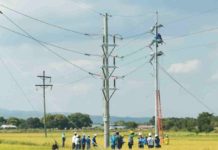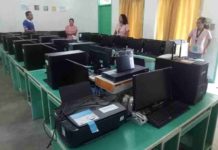[av_one_full first min_height=” vertical_alignment=” space=” custom_margin=” margin=’0px’ padding=’0px’ border=” border_color=” radius=’0px’ background_color=” src=” background_position=’top left’ background_repeat=’no-repeat’ animation=”]
[av_heading heading=’Differentiated instruction and the teaching of physical education ‘ tag=’h3′ style=’blockquote modern-quote’ size=” subheading_active=’subheading_below’ subheading_size=’15’ padding=’10’ color=” custom_font=”]
By Priscilla L. Bolivar
[/av_heading]
[av_textblock size=” font_color=” color=”]
TEACHING physical education these days can be challenging. Students enter classes with varied skill sets, levels of confidence and interests, and it is difficult to to engage all of them, be it in the gym, during fitness activities or in the health classroom.
By using differentiation, physical education teachers can help students’ participate in the teaching-learning process. As health and physical educators, differentiation does not mean an entire shift from present practice; it means strengthening one’s approach to teaching and learning by making small changes in the current practice to enhance students’ learning.
Meanwhile, teachers of physical education at Enrique B. Magalona National Comprehensive High School face a lot of challenges in teaching their subject to high schoolers. As a brief background about the situation, Enrique B. Magalona(also known as E.B. Magalona and formerly known as Saravia) is a second class municipality in the province of Negros Occidental. According to the 2010 census, it has a population of 59,434 people (DILG, 2013). The municipality is named after Enrique B. Magalona, former Senator of the Philippines and grandfather of the late Filipino rap icon Francis Magalona.
Now, differentiation refers to modified instructions that help students with diverse academic needs master the same challenging academic content as their peers. Although it might seem like a daunting task, designing and applying a variety of strategies in a classroom can be done through a variety of levels. Teachers can differentiate instruction with an individual student, within a small group, or with the whole class. Differentiating does not mean providing separate, unrelated activities for each student, but facilitating interrelated activities based on students’ needs and for the purpose of ensuring that all students comprehend a particular skill or idea (Good, 2006).
Carol Tomlinson (2000), a noted expert on differentiation, points out that students are more successful when they are taught based on their own readiness levels, interests, and learning profiles. This paper simply gives an overview of what differentiated instruction is, and how any physical education teacher can make use of it in the teaching-learning process.
For instance, in a classroom where there are talented pupils, differentiated instruction gives them opportunities to operate at a higher level, and extends their boundaries and expectations even further. In mixed ability groups this causes problems, because establishing differentiated practices challenge each individual in the group according to their needs. When teaching mixed ability groups, there may also be a tendency to pitch the level of the lesson at the mean, the middle and the mass in order to fulfil the expectations of the national curriculum and this has obvious implications for talented pupils who remain unchallenged.
Another instance of differentiation is in the teaching of physical education, which involves the use of space within physical activity environments. For instance in games activities, it is generally recognized that a decrease in the amount of space a student has would lead to an increase in pressure on his or her performance. Thus, to create the right level of challenge, space is a critical factor in regulating the opportunities for success at an appropriate level for the child. In some instances the use of more or less space may stimulate innovative thought and would therefore be suitable for children with high levels of creativity.
Another differentiated situation is the roles that students play inside the classroom. What this means is that just because a pupil can perform outstandingly in a specific area, it does not mean that this may competent at, or comfortable with, coaching their peers.
However, the use of a variety of roles does have a place in PE and talent development in PE. Talented pupils with high levels of social ability in particular will thrive in the role of evaluator, leader, coach or manager. Likewise, the use of a particular teaching style will have an enormous impact on the potential of children who possess a wide range of abilities, and may give them access to many other high quality learning experiences.
Mosston & Ashworth (1986) developed a teaching spectrum, which maps out teaching styles that range from command style to discovery. The teaching styles section of the CD explores the impact of teaching styles on different areas of abilities, and offers suggestions of teaching style methods for developing specific abilities.
Students’ response is also another consideration about differentiation. Children’s responses should determine subsequent content and teaching styles. Crucial to the on-going development of provision, the key to success here is to elicit positive response from a variety of ways to ensure the preferred learning and thinking styles of each child is catered for. In PE, this can take the form of an on going dialogue of questions and answers, demonstration, group discussion and verbal feedback within analysis of performance.
Resources can also come to play in differentiated instruction. Provision for talent development in Physical Education can be significantly enhanced through the use of appropriate resources. Although the availability of ICT resources have allowed some teachers the opportunity to experiment with a range of delivery tools, there still remains the need to assess the educational virtues of selecting certain resources to support teaching and learning.
Differentiation is a way of teaching. It is not a program or package of worksheets. It asks teachers to know their students well so they can provide each one with experiences and tasks that will improve their learning experiences. As Carol Ann Tomlinson said, differentiation means giving students multiple options for taking in information (1999). Differentiating instruction means that one observes and understands the differences and similarities among students, and then use this information to plan effective instruction strategies.
It is also important to know the learning profile and interests of your students. It is an essential element in planning for differentiation. Learning inventories may be used to help students understand how they prefer to process information, their intelligence preferences, and whether they prefer to learn in a group setting or through independent inquiry. Furthermore, learning inventories can also improve their ability to learn through oral, visual or kinaesthetic experiences.
Additionally, a student’s interest peaks his or her motivation to explore ideas and concepts. Thus, the goal of differentiating lessons for different students is to offer a variety of choices, so that students may learn through methods that work best for them about topics of interest within the scope of the curriculum. The end result is usually an improvement in student learning.
Finally, differentiation is about all students “…getting the opportunities they need so they all have equal access to learning in a way that will lead to their success as well as opportunities to demonstrate their learning that maximize their potential for success” (Differentiated Instruction Teacher’s Guide: Getting to the core of teaching and learning. Ontario Ministry of Education, 2007). There is no more important place for the differentiation for successful learning to occur than in Health and Physical Education, where the goal of the curriculum is to help all students develop the comprehension, commitment, and capacity to lead a healthy active life./PN
[/av_textblock]
[/av_one_full]



